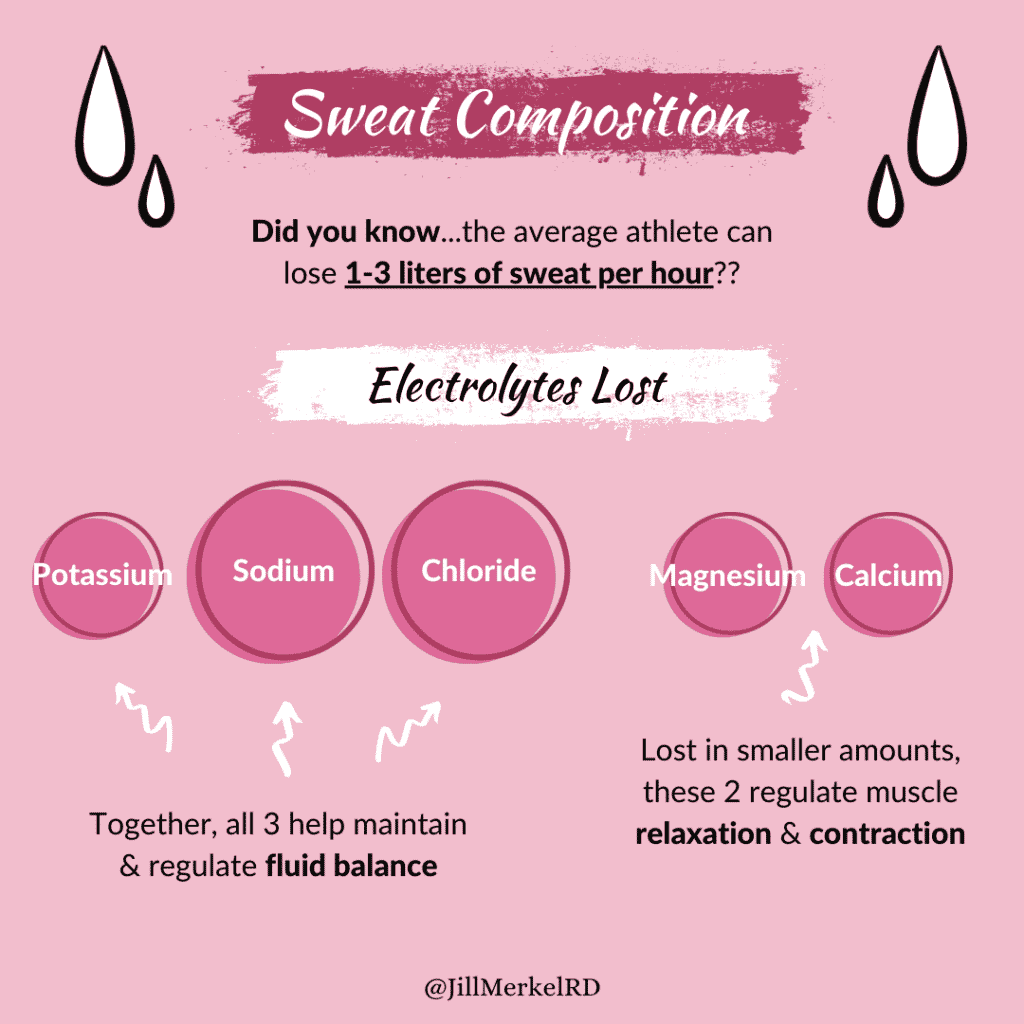Have you ever thought about what all makes up sweat composition? We often think that if we sweat a lot or feel dehydrated, that we just need to drink water. But, especially for athletes and active individuals, there’s more to it than that.
Let’s take a look.
Sweat Composition
Sweat is composed of more than just water; it contains electrolytes that help to maintain bodily functions throughout the day and during exercise.
The five electrolytes of importance are:
- sodium
- chloride
- potassium
- magnesium
- calcium

Sweat Composition – Electrolytes
Magnesium and calcium help to maintain optimal muscle function, such as muscle contraction and relaxation, and play an important role in energy metabolism. These two electrolytes are lost in small amounts, but this does not mean foods containing calcium and magnesium should not be consumed. Electrolyte losses from recurrent training bouts add up!
Sodium, chloride, and potassium help to regulate and maintain fluid balance. While potassium, magnesium, and calcium are lost in sweat, larger amounts of sodium and chloride are lost and must be adequately replenished.
Sodium and chloride together are known as salt. Consuming salty snacks pre or post-exercise is commonly suggested by sports dietitians to help with electrolyte replenishment. Sports drinks, such as Gatorade, have some of these electrolytes plus carbohydrates, which both help to maintain fluid status during exercise. Salty foods and drinks before, during, and after also help to sustain fluid intake since salt makes you thirsty and therefore, more likely to consume fluids.
Sweat Composition – Amounts
The average athlete can lose 1-3 liters of sweat per hour. Sweat rates vary between athletes; this is why it is important to monitor sweat losses from time to time to find your own average sweat rate. Athletes that sweat more than others typically have a white residue on their shirts when exercising and may have more frequency of muscle cramps.
A general rule of thumb is for every pound of sweat lost during exercise, you should drink 16-24 ounces of fluids. Also, for every pound of sweat lost, about 500 milligrams of sodium is lost. Below is a chart that helps illustrate how much fluid is needed for replenishment and how much sodium is lost per pound of sweat.

Foods high in sodium:
- Sports Drinks
- Pretzels
- Pickles or Pickle juice
- Nuts
- Beef or Turkey Jerky
- Guacamole
- Goldfish crackers
- Trail mix
- Crackers
Foods high in potassium:
- Bananas
- Potatoes
- Dark leafy greens
- Citrus fruits
Foods high in magnesium:
- Pumpkin seeds
- Almonds
- Cashews
- Peanut butter
- Spinach
- Beans
Foods high in calcium:
- Milk
- Yogurt
- Almonds
- Broccoli
Sweat Composition – Muscle Cramping
People commonly mistake potassium loss to be the cause of muscle cramps during exercise. This is why you see individuals encourage athletes with cramps to consume potassium-containing foods, such as bananas and oranges.
However, potassium loss in sweat is much smaller than sodium loss. Ensuring adequate sodium replenishment with fluids will help to decrease muscle cramps as well as ensuring adequate calorie and carbohydrate intake for optimal muscle fueling.
Looking for More?
I offer individual sports nutrition coaching to help you fuel and hydrate your body for optimal performance.

